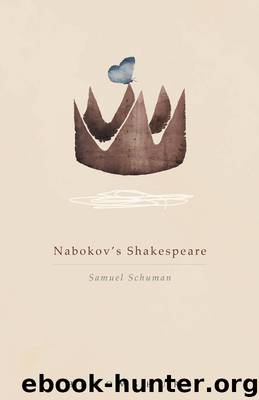Nabokov's Shakespeare by Schuman Samuel;

Author:Schuman, Samuel; [Schuman, Samuel]
Language: eng
Format: epub
ISBN: 1718530
Publisher: Bloomsbury Publishing
For comparative purposes here, again, is the passage as Kinbote quoted it some 150 pages earlier, filtered through the translations of Conmal (Shakespeare’s English into Zemblan) and Kinbote (Conmal’s Zemblan back into English):
The sun is a thief; she lures the sea
and robs it. The moon is a thief:
he steals his silvery light from the sun
The sea is a thief: it dissolves the moon.
Shakespeare’s “pale fire” emerges as Conmal/Kinbote’s “silvery light.”
Amusingly, Kinbote criticizes Shade (and Nabokov) for indulging in the custom of naming works of literature after quotations from other earlier works: Shade entitled a collection of essays “The Untamed Seahorse” and Kinbote’s note reads:
See Browning’s My Last Duchess.
See it and condemn the fashionable device of entitling a collection of essays or a volume of poetry—or a long poem, alas, with a phrase from a more or less celebrated poetical work of the past. Such titles possess a specious glamor acceptable maybe in the names of vintage wines and plump courtesans but only degrading in regard to the talent that substitutes the easy allusiveness of literacy for original fancy and shifts onto a bust’s shoulders the responsibility for ornateness since anybody can flip through a Midsummer Night’s Dream or Romeo and Juliet, or, perhaps, the Sonnets and take his pick. (240)
It appears that, in the final sentence here, Kinbote is perhaps guessing at the source of Shade’s title. Later, in the index, he has another guess. Under the (very long) entry for “Kinbote, Charles, Dr.” we find “his severe criticism of quotational titles, from The Tempest etc., such as ‘pale fire,’ etc.” (309).
***
In addition to presenting the solution to an amusing literary puzzle, the discovery of the correct passage points to several important considerations in the novel.
The amusing game of tracking down the source of the novel’s title reaffirms Nabokov’s very serious and recurring thematic consideration of “coincidence.” Kinbote/Charles just happened to discover the escape passage as a child, note therein a copy of Timon of Athens; to pick up that copy fifteen years later while making his escape; to write a commentary on a poem which had as its title a line from Timon, at that point the only book in his possession; and to have already cited that specific line in his notes but in an unrecognizable twice-translated version. This is quite a sequence of accidents, and Nabokov invites the discerning reader to ponder their improbability with Kinbote’s unconsciously ironic statement about “a statistical monster.” Of course, the point we are meant to realize is that this chain of events is not accidental nor coincidental nor monstrous at all—it only seems that way to Charles Kinbote. From our more knowledgeable perspective, it is clear that everything has been planned and carefully wrought. The “pale fire”—Timon of Athens’ sequence is not part of some random life; it is part of a novel’s plot, imagined, structured, and built by Nabokov. The author of Pale Fire is using Shakespeare’s play to remind us that the novel is an aesthetic construct, not “reality” but an artifice created by an artificer.
Download
This site does not store any files on its server. We only index and link to content provided by other sites. Please contact the content providers to delete copyright contents if any and email us, we'll remove relevant links or contents immediately.
| African | Asian |
| Australian & Oceanian | Canadian |
| Caribbean & Latin American | European |
| Jewish | Middle Eastern |
| Russian | United States |
4 3 2 1: A Novel by Paul Auster(12260)
The handmaid's tale by Margaret Atwood(7660)
Giovanni's Room by James Baldwin(7160)
Asking the Right Questions: A Guide to Critical Thinking by M. Neil Browne & Stuart M. Keeley(5598)
Big Magic: Creative Living Beyond Fear by Elizabeth Gilbert(5575)
Ego Is the Enemy by Ryan Holiday(5263)
The Body: A Guide for Occupants by Bill Bryson(4943)
On Writing A Memoir of the Craft by Stephen King(4846)
Ken Follett - World without end by Ken Follett(4617)
Adulting by Kelly Williams Brown(4462)
Bluets by Maggie Nelson(4456)
Eat That Frog! by Brian Tracy(4407)
Guilty Pleasures by Laurell K Hamilton(4337)
The Poetry of Pablo Neruda by Pablo Neruda(4016)
Alive: The Story of the Andes Survivors by Piers Paul Read(3953)
White Noise - A Novel by Don DeLillo(3935)
Fingerprints of the Gods by Graham Hancock(3922)
The Book of Joy by Dalai Lama(3879)
The Bookshop by Penelope Fitzgerald(3759)
